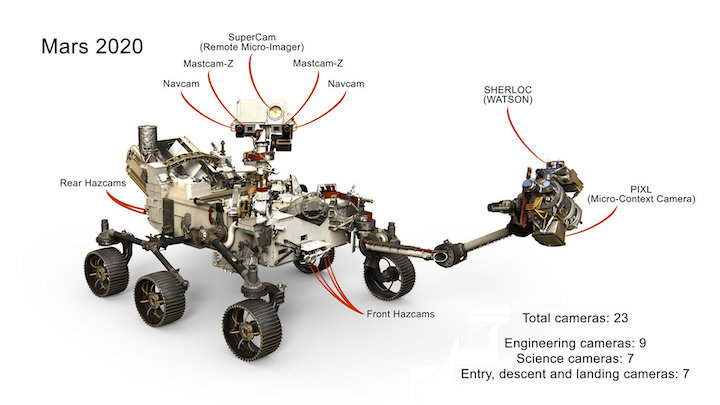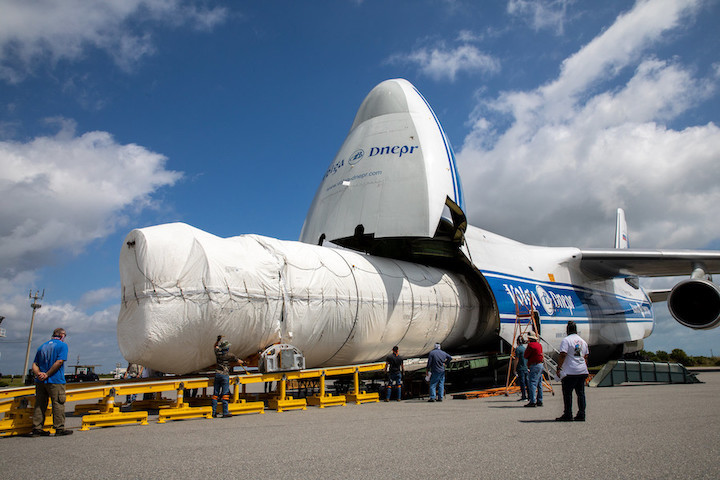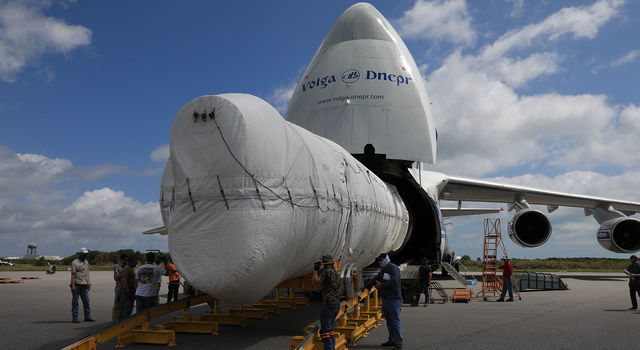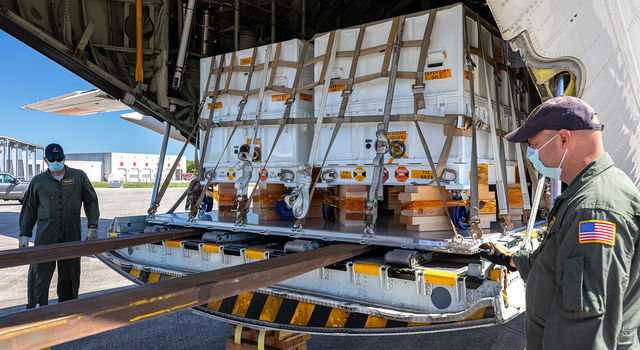19.05.2020

While auto manufacturers built over 92 million motor vehicles for this world in 2019, NASA built just one for Mars. The Perseverance Mars rover is one of a kind, and the testing required to get it ready to roll on the mean (and unpaved) streets of the Red Planet is one of a kind as well.
Because hardware cannot be repaired once the rover is on Mars, the team has to build a vehicle that can survive for years on a planet with punishing temperature shifts, constant radiation and ever-present dust. To ensure readiness, they put Perseverance through a test program tougher than the trip to Mars and the environment it will encounter once there.
"Mars is hard, and everybody knows that," said project manager John McNamee of NASA's Jet Propulsion Laboratory in Southern California. "What they may not realize is that to be successful at Mars, you have to test the absolute heck out of the thing here on Earth."
While the unique tests performed for the project number in the thousands, here's a handful that stand out.
The Sound and Fury
It is no secret that loud noises can be detrimental to your hearing. They can also be detrimental to a spacecraft, at least when they're at the level encountered atop the launch vehicle during liftoff. Those punishing decibels can actually cause parts and components to come loose.
Long before the rover was shipped to Kennedy Space Center in Florida in preparation for this summer's launch, engineers put it in a special chamber at JPL and, using nitrogen-charged speakers, blasted away at it with random waves of sound as high as about 143 decibels — louder than what you'd encounter standing behind a roaring jet engine. On several occasions during the daylong acoustical test, they halted to inspect the rover and its surroundings, looking for anything that might have loosened, broken or fallen off. Some fasteners attaching spacecraft components had to be tightened and a few electrical cables replaced, but the mission team came away with increased confidence that while Perseverance will certainly be shaken during launch, nothing should stir.
Oh, Chute
Ask any member of the Mars 2020 mission's entry, descent and landing team, and they'll tell you there's little point in traveling through 314 million miles (505 million kilometers) of interplanetary space if you can't stick the landing. At 70.5 feet (21.5 meters) in diameter, the rover's supersonic parachute has everything to do with making that happen. A lot of work goes into ensuring a chute deploys right and can do the job without shredding or getting tangled.
Perseverance's parachute is based on the design successfully flown by Mars Curiosity in 2012. However, since Perseverance is slightly heavier than Curiosity, engineers strengthened their parachute design. But how to be sure it will do what is expected of it? Test, test, test.
First, the team focused on verifying the chute would hold up under the strain of slowing a fast-moving spacecraft down in the Martian atmosphere. In the summer of 2017, they traveled to the National Full-Scale Aerodynamics Complex at NASA's Ames Research in California's Silicon Valley to observe trial chute deployments close up in a wind tunnel, checking workmanship and looking for any unexpected behavior.
More complex evaluations would come between March and September 2018. The team tested the chute three times in Mars-relevant conditions, using Black Brant IX sounding rockets launched from NASA's Wallops Flight Research Facility in Virginia. The final test flight, on Sept. 7, exposed the chute to a 67,000-pound (37,000-kilogram) load — the highest ever survived by a supersonic parachute and about 85% higher than what the mission's chute is expected to encounter during deployment in Mars' atmosphere.
The team also tested the chute's deployment mortar. Perseverance's parachute is packed into an aluminum canister so tightly, it has the density of oak. The mortar is a cylindrical canister cradled atop the aeroshell, which encapsulates the rover. At the time of deployment, an explosive propellant at the base of the mortar will launch the carefully bundled array of nylon, Technora and Kevlar at just the right velocity and trajectory into the Martian slipstream.
Mortar deployment evaluations took place in the winter of 2019 at a test facility in central Washington. The temperature of the mortar canister during the first test synched closely with the ambient air temperature — about 70 degrees Fahrenheit (21 degrees Celsius). The second and third were executed with the mortar chilled to minus 67 degrees Fahrenheit (minus 55 degrees Celsius) — well below the temperature at which the mortar is expected to fire during the actual deployment at Mars (14 degrees Fahrenheit, or minus 10 degrees Centigrade). The mortar passed all three tests with flying colors.
Running Hot and Cold
The Sun's rays heat a white-painted rover differently than they would, say, a Mars boulder. To better understand what temperature-sensitive instruments and subsystems will encounter, the team tested Perseverance's "thermal model." In October 2019, they placed the rover in JPL's 25-foot-wide, 85-foot-tall (8-meter-by-26-meter) vacuum chamber for a daylong test, where powerful xenon lamps several floors below beamed upward, hitting a mirror at the top of the chamber to drench the spacecraft with light.
After the lamps warmed up and reached the same intensity of sunlight the rover will encounter at its landing site in Jezero Crater, an engineer climbed in and measured the "sunlight" reaching different portions of the rover. Data from the test was used to update the rover's thermal model, giving the team the assurance they needed to proceed with next step in ground-based cold testing.
Once the solar-intensity tests concluded, engineers closed the doors and evacuated the majority of the atmosphere in the chamber to simulate Mars' thin atmosphere, which has about 1% the atmospheric density of Earth. Then the chamber was chilled to minus 200 degrees Fahrenheit (minus 129 degrees Celsius), and for a weeklong subsystems check, they ran computer programs, raised the remote sensing mast and antennas, turned wheels, and deployed the Mars Helicopter to make sure the rover can handle even the coldest Martian nights.
Camera Ready
The Mars 2020 mission is launching 25 cameras to the Red Planet, a record number for an interplanetary expedition. After installation, each camera bound for the Red Planet had to undergo an "eye" exam.
With a camera called WATSON, which is tasked with taking close-up pictures and (if needed) video of rock textures, project engineers recorded the scene as they danced and waved. The goal: to determine the imager's frame rate and exposure time, and the ability of its computer to hold and transfer the data.
For other imagers, the test was a little more formal and rigorous. The process is called machine-vision calibration and involves using target boards featuring grids to establish a baseline for a camera's optical performance. The result? The mission's vision was 2020.
About the Mars 2020 Mission
Whether they are working on final assembly of the vehicle at Kennedy Space Center, testing software and subsystems at JPL, or (as the majority of the team is doing) teleworking due to coronavirus safety precautions, the Perseverance team remains on track to meet the opening of the rover's launch period. No matter what day Perseverance launches, it will land at Mars' Jezero Crater on Feb. 18, 2021.
The Perseverance rover's astrobiology mission will search for signs of ancient microbial life. It will also characterize the planet's climate and geology, collect samples for future return to Earth, and pave the way for human exploration of the Red Planet. The Perseverance rover mission is part of a larger program that includes missions to the Moon as a way to prepare for human exploration of the Red Planet. Charged with returning astronauts to the Moon by 2024, NASA will establish a sustained human presence on and around the Moon by 2028 through NASA's Artemis lunar exploration plans.
Quelle: NASA
----
Update: 25.05.2020
.
Air Deliveries Bring NASA's Perseverance Mars Rover Closer to Launch
A NASA Wallops Flight Facility cargo plane transported more than two tons of equipment - including the rover's sample collection tubes - to Florida for this summer's liftoff.
Progress continues to speed along as NASA's Perseverance rover readies for its launch this summer. On May 11, the rover team at the agency's Kennedy Space Center in Florida received the tubes tasked with holding the first samples collected at Mars for eventual return to Earth. A week later, the Atlas V launch vehicle that will hurl Perseverance to the Red Planet arrived at the launch site. Working together, personnel from NASA's Jet Propulsion Laboratory in Southern California and United Launch Alliance in Centennial, Colorado, were also able to extend the rover's launch period by six days, from Jul. 17-Aug. 5 to Jul. 17-Aug. 11.
The sample tubes will be filled with Martian rock and sediment and deposited on the planet for a future mission to return to Earth to be studied. They're part of the rover's Sample Caching System, the most complex and capable mechanism of its kind to be sent into space to address the question of potential life beyond Earth.
The tubes and their seals were among the nearly 5,000 pounds (2,270 kilograms) of mission flight hardware, test gear and equipment that traveled from JPL to NASA's Armstrong Flight Research Center in Palmdale, California. On May 10, the equipment was loaded onto a C-130 cargo plane from NASA's Wallops Flight Facility in Virginia. The following day, the crew set out for Florida, touching down on Kennedy Space Center's Launch and Landing Facility a little before 3 p.m. local time. They were back at Wallops that evening.
A week later, on May 18, a giant Antonov cargo plane delivered the first stage of the mission's Atlas V launch vehicle, arriving at Kennedy Space Center just after 4 p.m. local time. The following day the booster was transported to the Atlas Spaceflight Operations Center at Cape Canaveral Air Force Station.
Once final testing is complete, the Atlas will be moved to the Vertical Integration Facility at Space Launch Complex 41, where preparations for the launch of Perseverance have begun following the successful Atlas V launch of the USSF-7 mission on May 17. Next, the Centaur upper stage and the payload fairing, which protects the spacecraft during launch, will be stacked on top of it.
Perseverance's Launch Period
Along with welcoming these key deliveries, Perseverance's team recently extended the mission's launch period - the range of days they can launch in order to reach Mars. Navigators calculated the original launch period, July 17-Aug. 5, over four years ago - long before the final weight of the spacecraft (the rover, the protective aeroshell in which it will travel to Mars, the descent stage, and the cruise stage that will take them there) could be well defined. With the new spacecraft data in hand, as well as an update on Atlas V performance margins from United Launch Alliance, the navigation team has expanded the period to Aug. 11.
"Vehicle design maturity is the space navigator's friend," said Fernando Abilleira, design and navigation manager for the mission. "We now have a 26-day launch period to get Perseverance on its way."
No matter what day Perseverance lifts off during its launch period, it will land in Mars' Jezero Crater on Feb. 18, 2021. Targeting landing for one specific date and time helps mission planners better understand lighting and temperature at the landing site, as well as the location of Mars-orbiting satellites tasked with recording and relaying spacecraft data during its descent and landing.
About the Mission
The Perseverance rover's astrobiology mission will search for signs of ancient microbial life. It will also characterize the planet's climate and geology, collect samples for future return to Earth and pave the way for human exploration of the Red Planet. The mission is part of a larger program that includes missions to the Moon as a way to prepare for human exploration of the Red Planet. Charged with returning astronauts to the Moon by 2024, NASA will establish a sustained human presence on and around the Moon by 2028 through NASA's Artemis lunar exploration plans.
Quelle: NASA
----
Update: 26.05.2020
.
Assembly of Mars rover’s rocket to begin this week

Two key pieces of hardware needed for NASA’s next Mars rover — an Atlas rocket booster and sterile components of the rover’s sample collection system — recently arrived at Cape Canaveral ahead of the mission’s scheduled launch July 17.
The first stage of United Launch Alliance’s Atlas 5 rocket arrived at Cape Canaveral Air Force Station’s Skid Strip runway May 18 aboard a Ukrainian-built Antonov An-124 transport plane. The cargo aircraft carried the 107-f0ot-long (32-meter) Atlas first stage from Huntsville, Alabama, near ULA’s rocket factory in Decatur.
After unloading the booster from the cargo jet, ULA moved the rocket into the Atlas Spaceflight Operations Center for post-shipment checks.
ULA typically delivers rocket hardware launch sites using the company’s ocean-going vessel named “RocketShip.” But the vessel recently ferried there Delta 4 rocket cores to Vandenberg Air Force Base in California, and was not available for the Atlas 5 shipment to Florida.
Rocket and rover preparations for the July launch are continuing with safeguards to mitigate impacts from the coronavirus pandemic.
Omar Baez, NASA’s launch director for the Perseverance mission, said the rocket’s arrival at Cape Canaveral and the successful launch of the previous Atlas 5 flight May 17 “should set us up with plenty of time for hitting the beginning of the (rover) launch window July 17.”
“Things are progressing as well as they can,” Baez said.
Liftoff is scheduled at 9:10 a.m. EDT (1310 GMT) on July 17, within a broader window extending from 9:00-10:40 a.m. EDT (1300-1440 GMT), according to Baez.
“We’re really looking forward to this one,” he said. “Things evolve from day-to-day. We learn from every mission as far as things that we have to do to protect ourselves and to prevent the team from getting sick.
“We’re definitely are encouraging people, unless they have a significant primary role, not to travel for the testing or the launch,” Baez said. “That work is progressing as best we can. Obviously, there’s a lot of teleworking, but when we do have to have the hands-on work, we try to do it in as safe of a manner as possible.”
Hardware for the Perseverance rover landed at the Kennedy Space Center’s Launch and Landing Facility on May 11 on a NASA C-130 transport plane. The delivery included the mission’s sample tubes, cigar-sized metal cylinders that will store rock samples collected by the Perseverance rover for retrieval and return to Earth by subsequent robotic missions.
The two hardware arrivals signaled the start of a new phase of launch preparations for the Perseverance rover, the centerpiece of NASA’s $2.5 billion Mars 2020 mission.
The 43 sampling tubes are part of the rover’s sample handling system, consisting of a robotic arm, motors, seals and a rotating array of nine drill bits for abrading, regolith collection, and coring of Martian rocks. The specimens drilled from rocks will be stored into the metallic tubes, where samples will be hermetically sealed to await arrival of a follow-on robotic mission in the late 2020s, which will return the material to Earth for analysis.

The Perseverance rover is inside the Payload Hazardous Servicing Facility at Kennedy, where ground teams are putting the final touches on the spacecraft before its closed up inside the payload fairing of its Atlas 5 launcher.
With the final pieces of the sampling system now at Kennedy, NASA teams planned to finish installing the mission’s heat shield. Other tasks planned in the next few weeks include fueling of the mission’s cruise stage, which will shepherd the rover during the seven-month journey from Earth to Mars.
The rover — enclosed inside its atmospheric entry capsule — will then be mated with the cruise stage and attached to the Atlas 5’s payload attachment fixture. The entire spacecraft will next be encapsulated inside the Atlas 5’s Swiss-made payload fairing, then transferred to ULA’s Vertical Integration Facility for integration with the launch vehicle.
Stacking of the Atlas 5 rocket — tail number AV-088 — is scheduled to get underway May 28 with the hoisting of the first stage vertical on top of the Atlas mobile launch platform inside the VIF, according to Omar Baez, NASA’s launch director for the Perseverance rover mission.
ULA ground crews transferred the mobile launch platform back inside the VIF from Cape Canaveral’s Complex 41 launch pad last week following liftoff of the previous Atlas 5 flight May 17.
The Atlas 5 for the Perseverance rover mission will fly in the “541” configuration with four strap-on solid rocket boosters and a 17.7-foot-diameter (5.4-meter) diameter payload fairing.
ULA will install the Atlas 5’s four solid-fueled boosters after raising the first stage inside the rocket’s vertical hangar.
The Atlas 5’s Centaur upper stage, which will propel the rover on an escape trajectory away from Earth, will be stacked on top of the rocket around June 4, Baez said.

ULA will roll the Atlas 5 rocket out to pad 41 on June 17 for a fueling test. ULA performs such fueling demonstrations before launches with limited planetary launch windows to ensure teams can detect and resolve any problems one the rocket before launch day.
The Atlas 5 will return to the VIF after the tanking test.
“After we’re done with that, we’ll mate the rover spacecraft to the Atlas-Centaur on June 22, do a test between it and the rocket, and that’ll set us up pretty much for our final reviews, installation of the RTG, doing a dress rehearsal, and getting our launch readiness review out of the way,” Baez said in an interview with Spaceflight Now.
The Multi-Mission Radioisotope Thermoelectric Generator, or MMRTG, is the rover’s nuclear power source. The device converts heat from the radioactive decay of plutonium into electricity. Provided by the U.S. Department of Energy, the power generator is one of the final items installed on the rover in the final weeks before launch.
The Atlas 5 rocket is the only launch vehicle currently certified by NASA to carry nuclear-powered payloads into space.
The rocket assigned to the Perseverance rover launch has no significant modifications from ULA’s standard Atlas 5 vehicle, Baez said.
But there’s one change to the pyrotechnic system that would be activated to destroy the Atlas 5 if it deviates from its planned course and threatens populated areas. Such an event is highly unlikely, and the Atlas 5 has successfully reached orbit on all 84 of its missions to date.
“If you did have some kind of accident, that’s to prevent the MMRTG from being a danger to the public,” Baez said. “So we try to be very precise in destroying, for example the Centaur (upper stage), in a way that the MMRTG is not in harms way, where it could harm the public. Thats about the only difference between this and a non-nuclear mission.”
Baez said the same type of ordnance system was used on the Atlas 5 rocket that launched the Curiosity Mars rover in 2011. The Perseverance rover is similar in design to Curiosity, but carries a different set of scientific instruments.
The Perseverance rover’s launch window extends from July 17 through Aug. 11. NASA and ULA recently assessed the performance of the Atlas 5 rocket and the final mass of the spacecraft, engineers determined they could add six days to the launch period.
Launch opportunities to Mars only come about once every 26 months, when the positions of the planets make a direct journey possible.
Quelle: SN









